Abstract
1. We evaluated a method of measuring cardiac baroreflex sensitivity (BRS) derived from spontaneous changes in systolic pressure (SP). SP was measured from the ECG signal in seven conscious, resting dogs. 2. Beat-to-beat changes in PI (dPI) were positively correlated with beat-to-beat changes in SP (dSP) in all dogs tested, suggesting spontaneous baroreflex function. The slope of the regression of dPI on dSP was used as an index of spontaneous BRS. 3. The spontaneous BRS was abolished by hexamethonium, atropine and bilateral carotid sinus denervation. Low dose atropine sulphate produced a paradoxical increase in spontaneous BRS, which has been observed in other studies. The spontaneous BRS was positively correlated with the average pulse interval in resting dogs. 4. Random modulation of heart rate after vagotomy failed to reproduce the strong positive correlation between dSP and dPI; this demonstrated that the correlation was not the result of mechanical coupling between heart rate and arterial blood pressure. 5. The BRS was measured pharmacologically in six dogs using a bolus injection of a vasoconstrictor. The pharmacological BRS was positively correlated with the spontaneous BRS measured after the bolus injection. 6. Finally, the spontaneous BRS was negatively correlated with the average arterial pressure in resting dogs. We conclude that the spontaneous BRS is a useful quantitative indicator of baroreflex function in conscious resting dogs.
Full text
PDF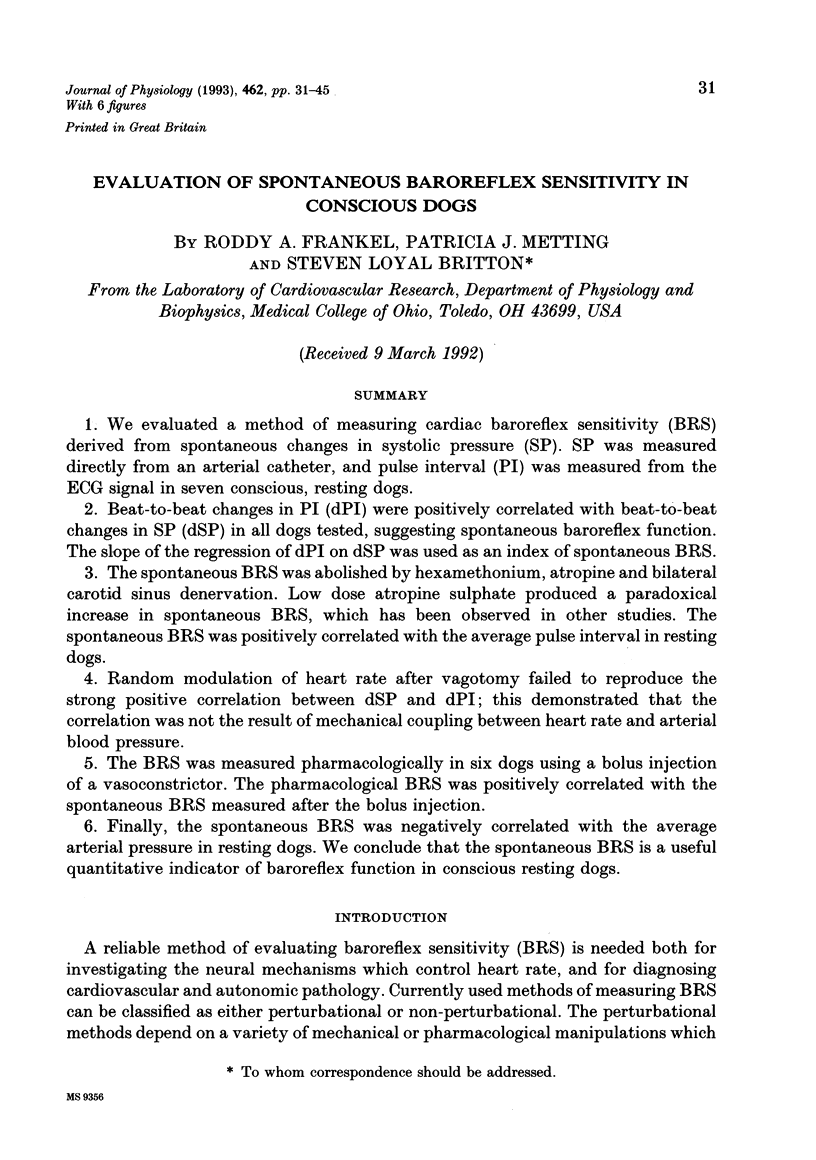
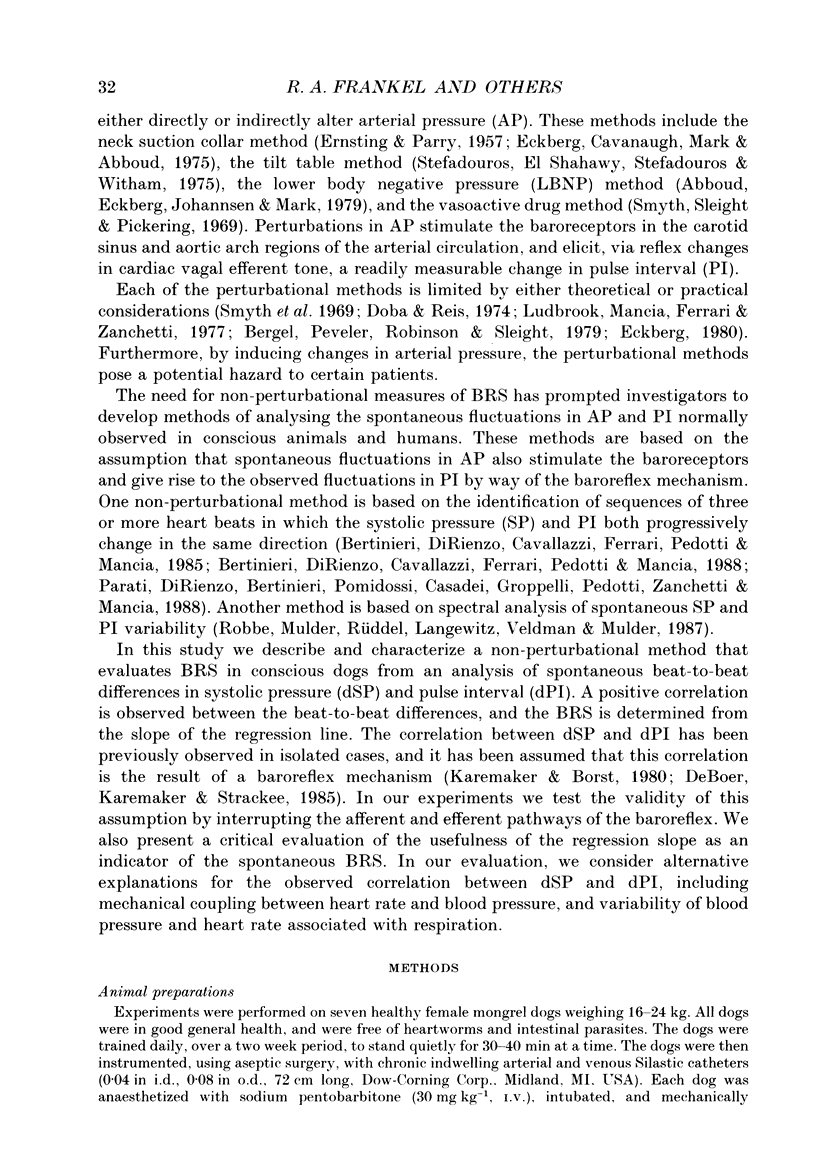
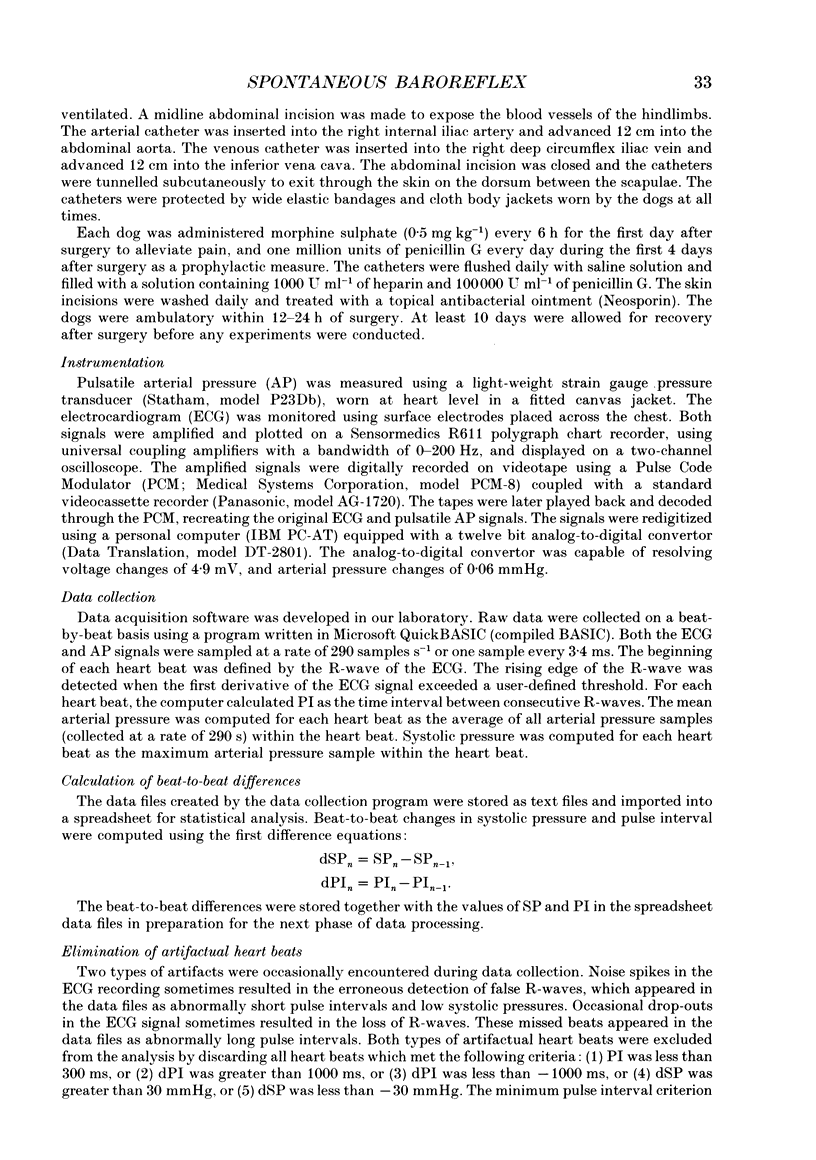

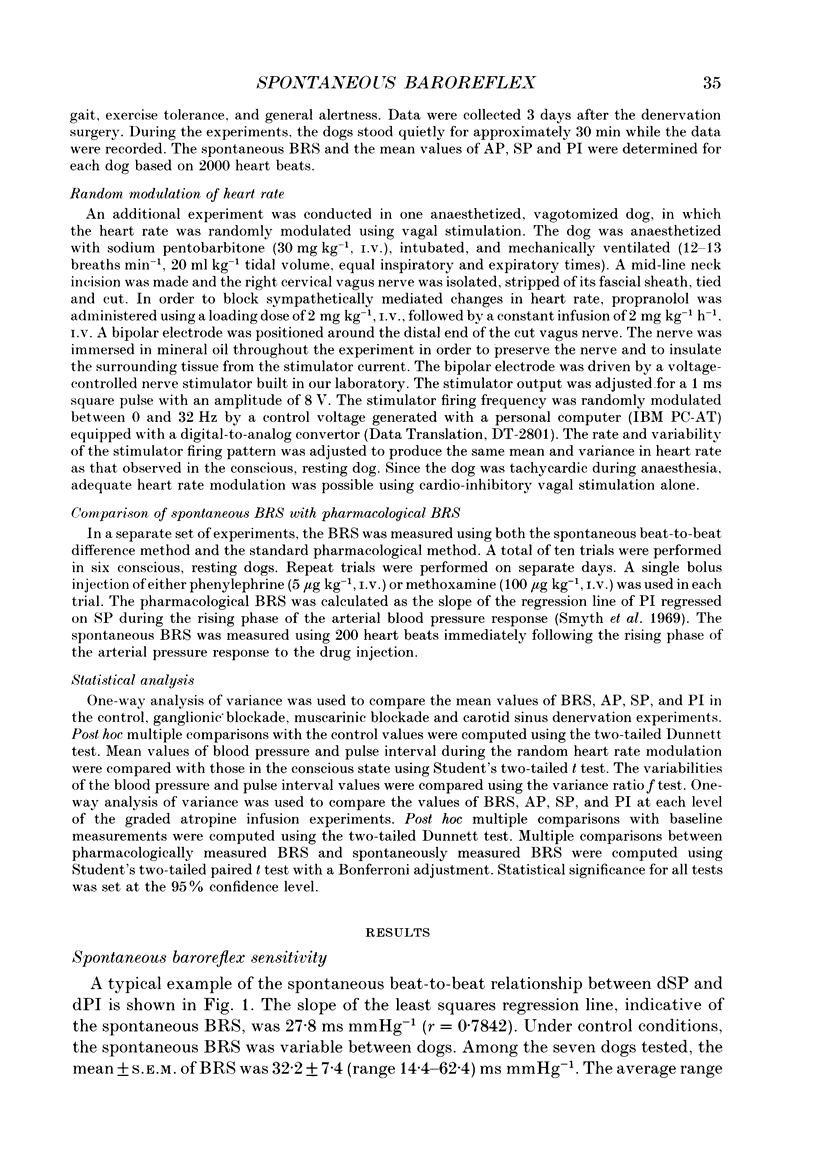
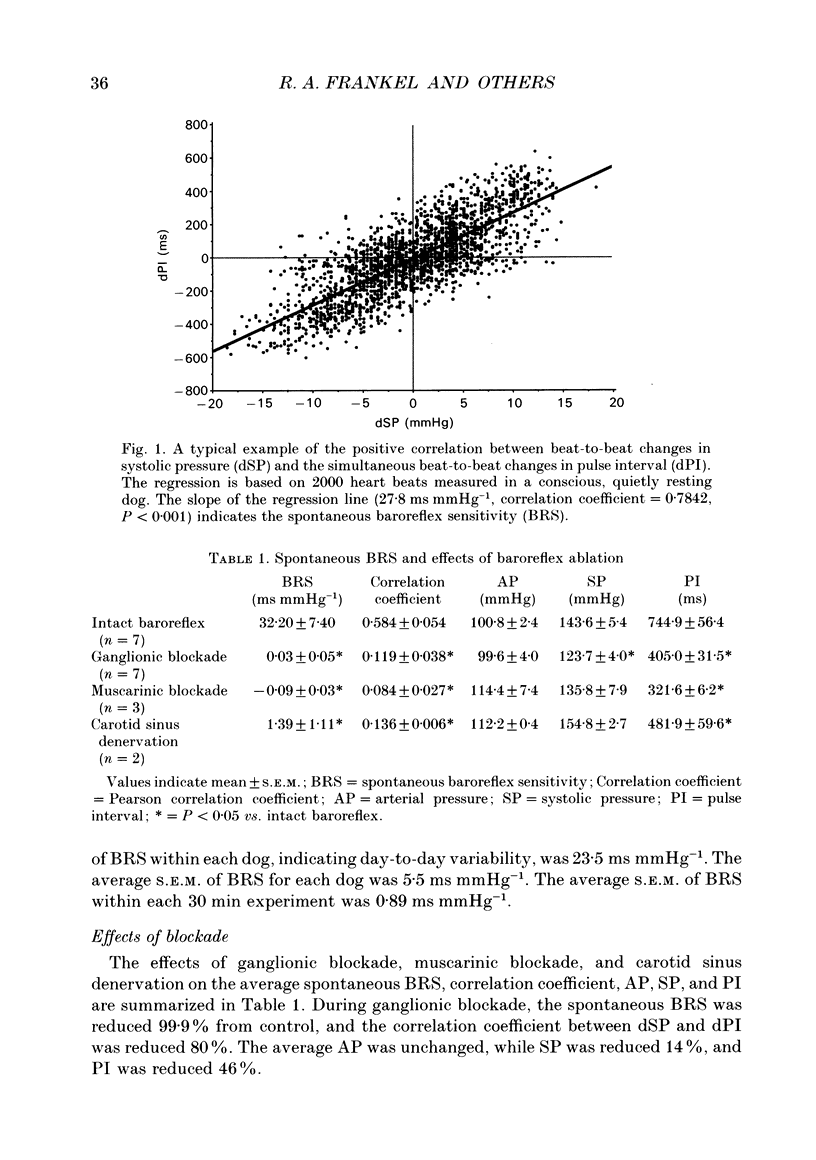
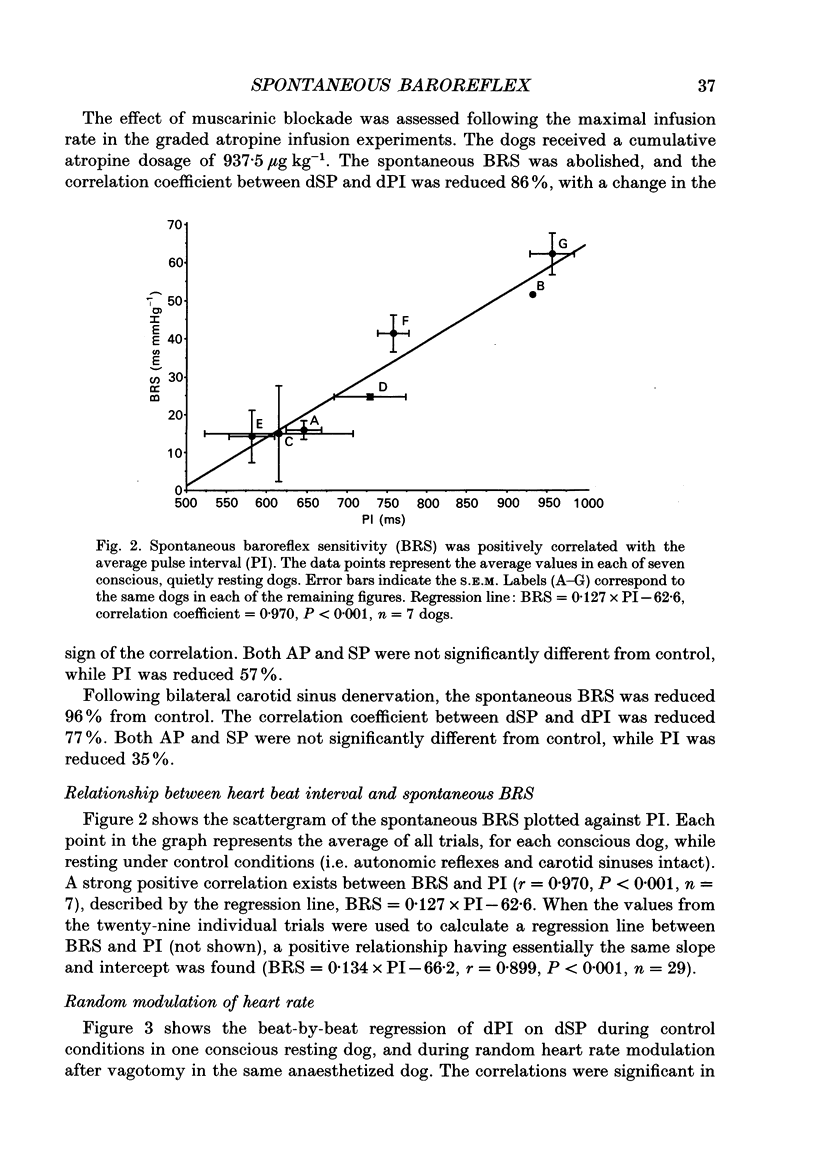
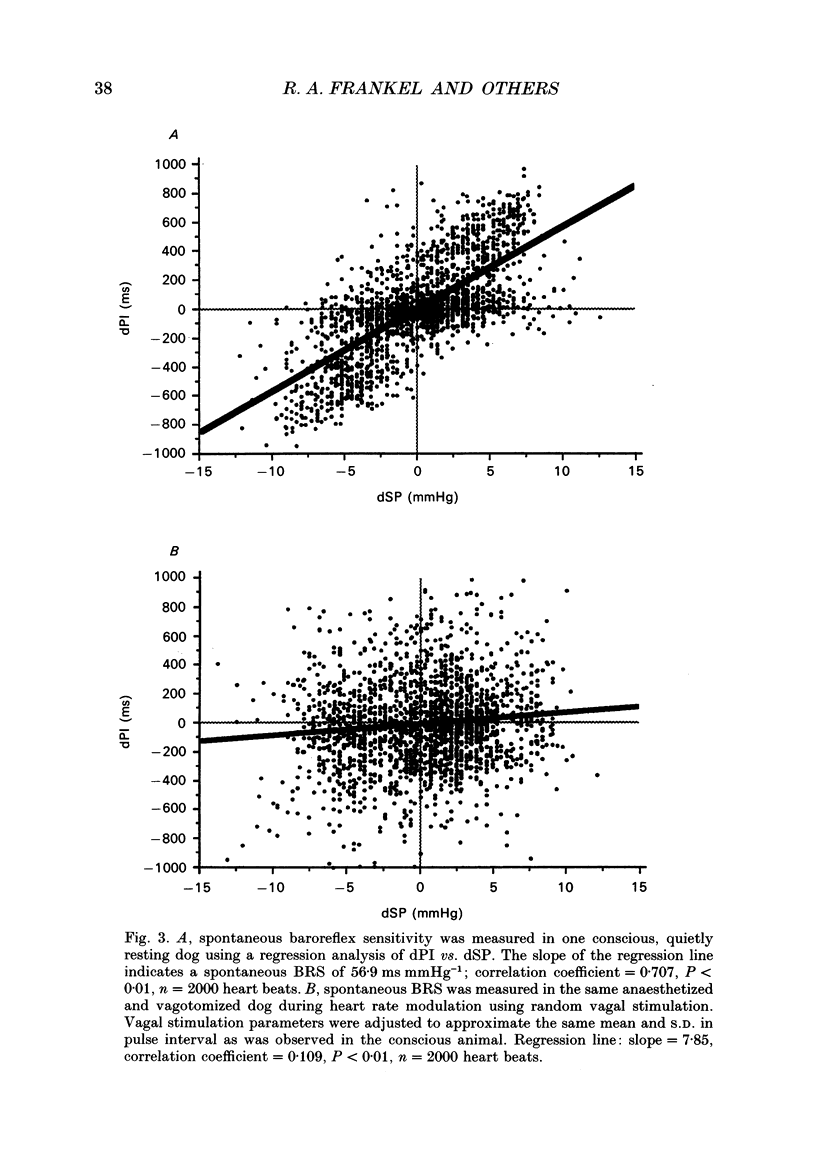
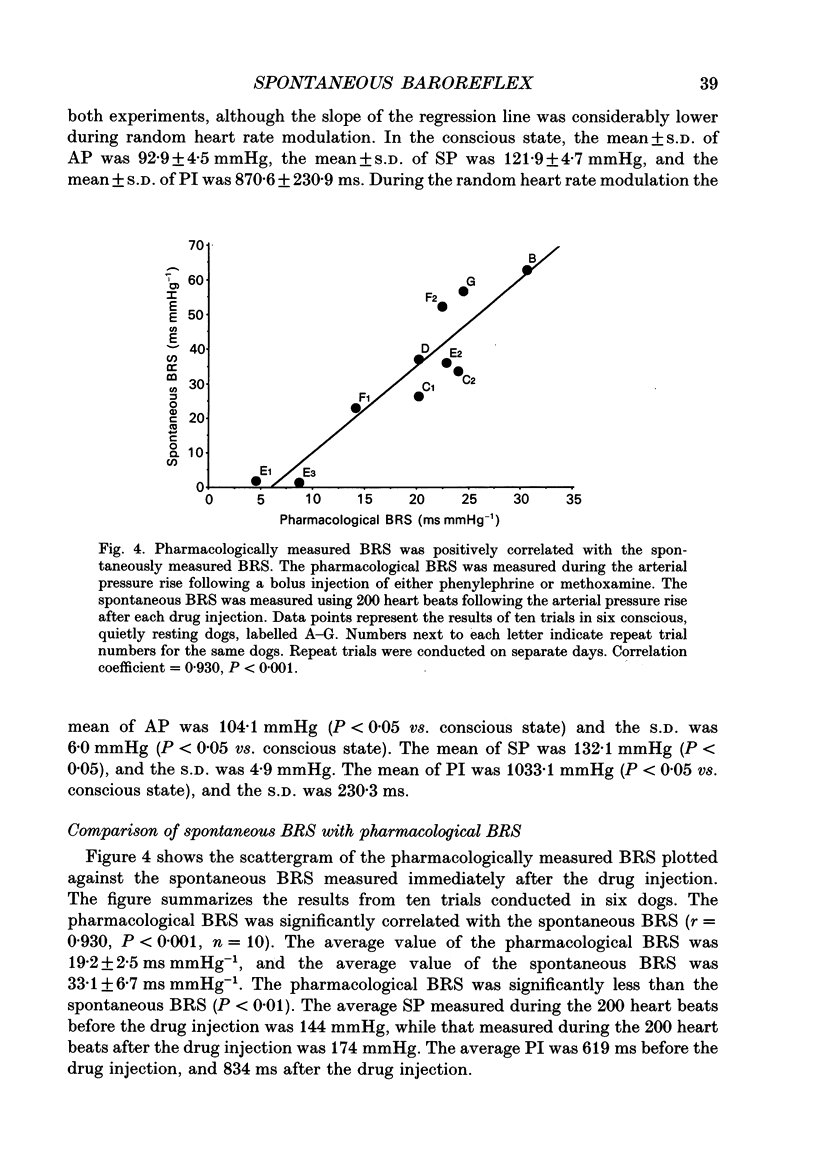
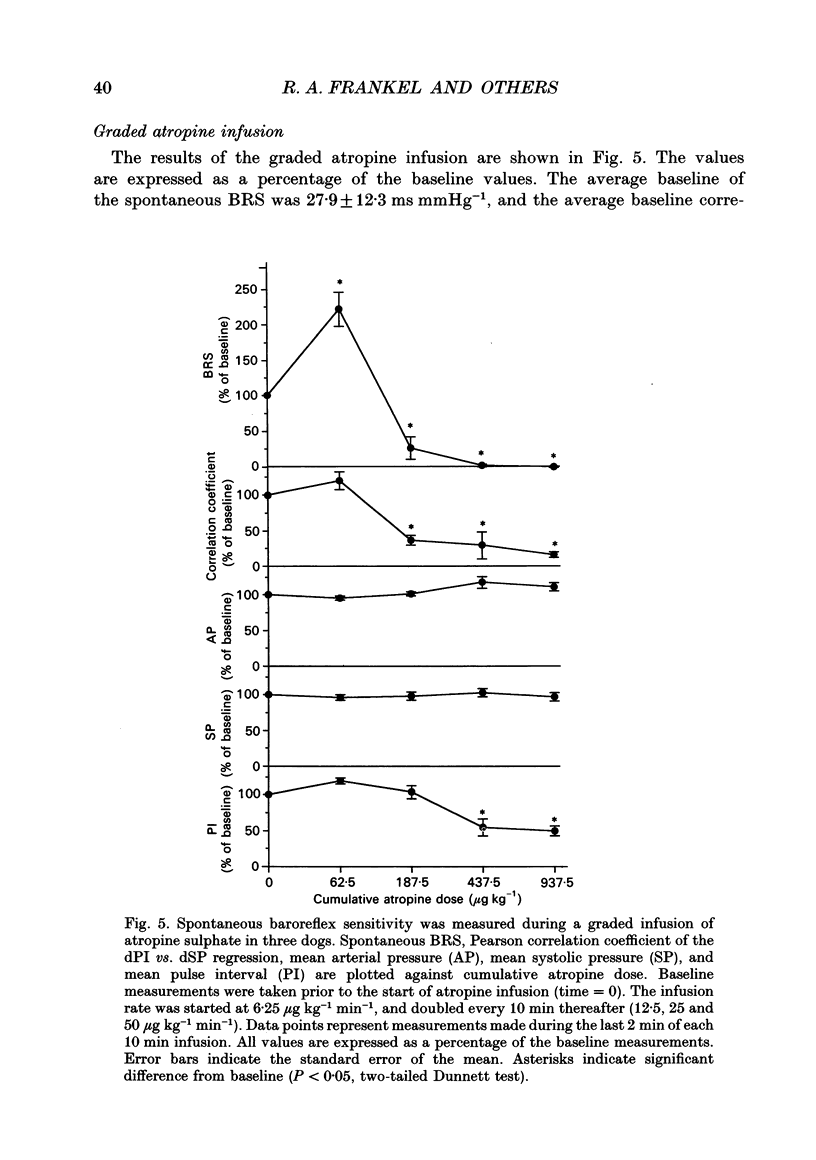
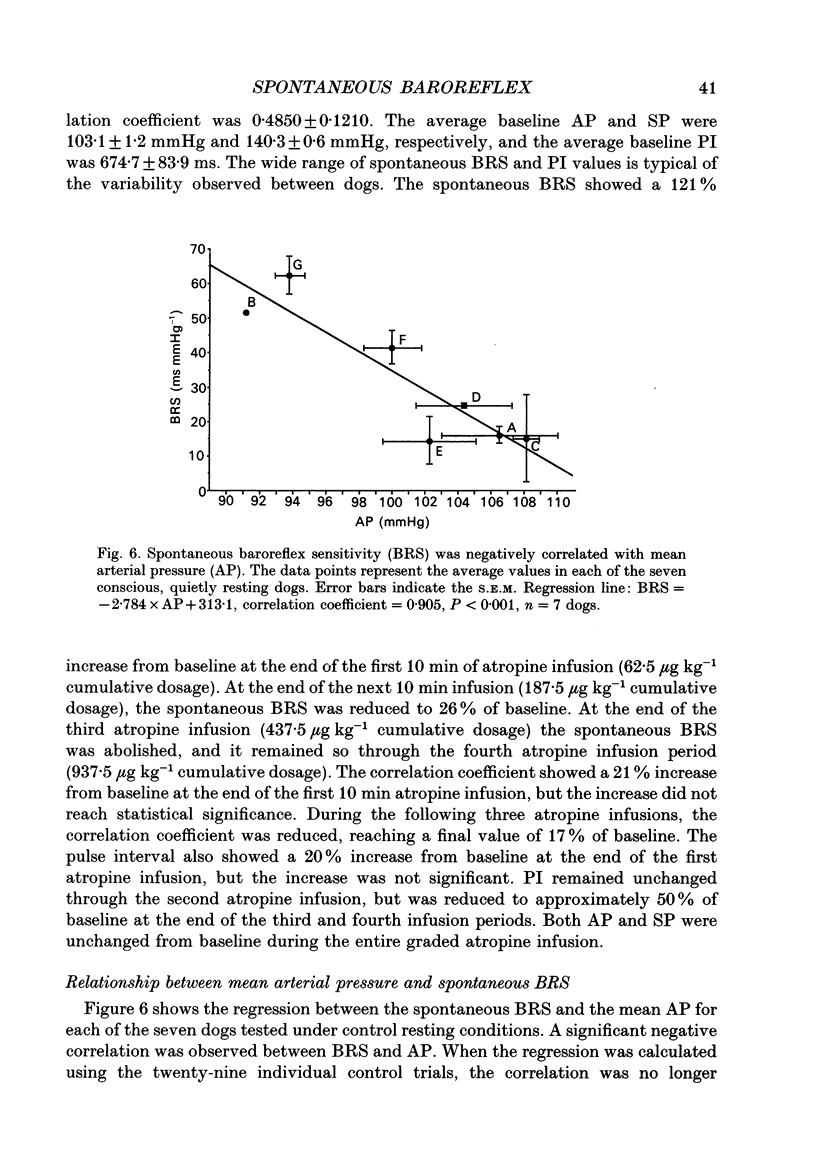
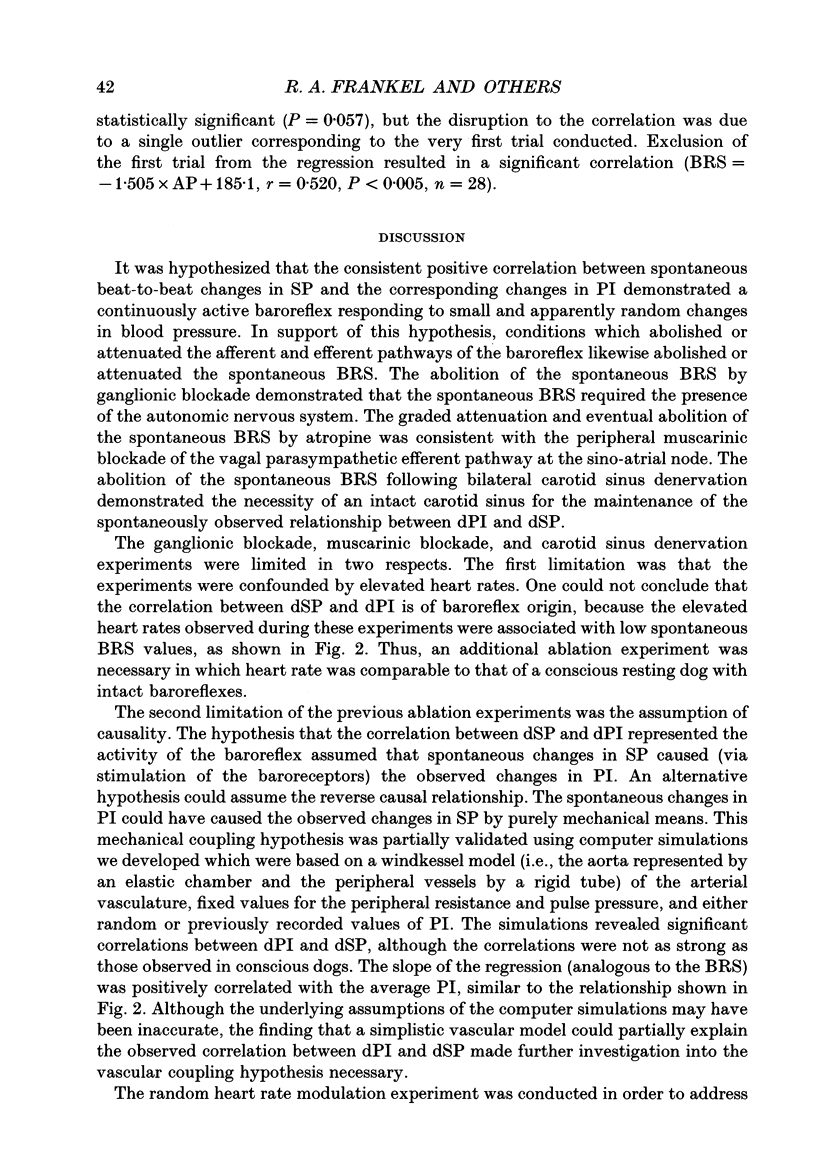
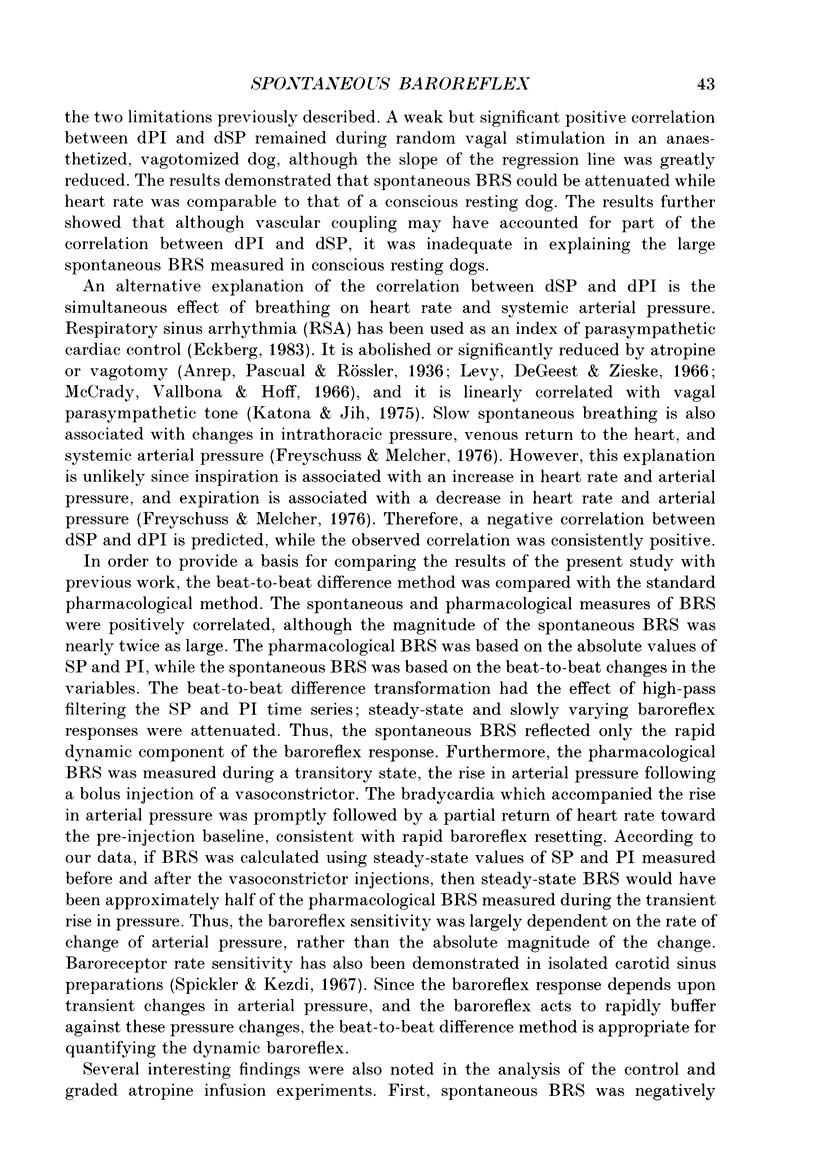
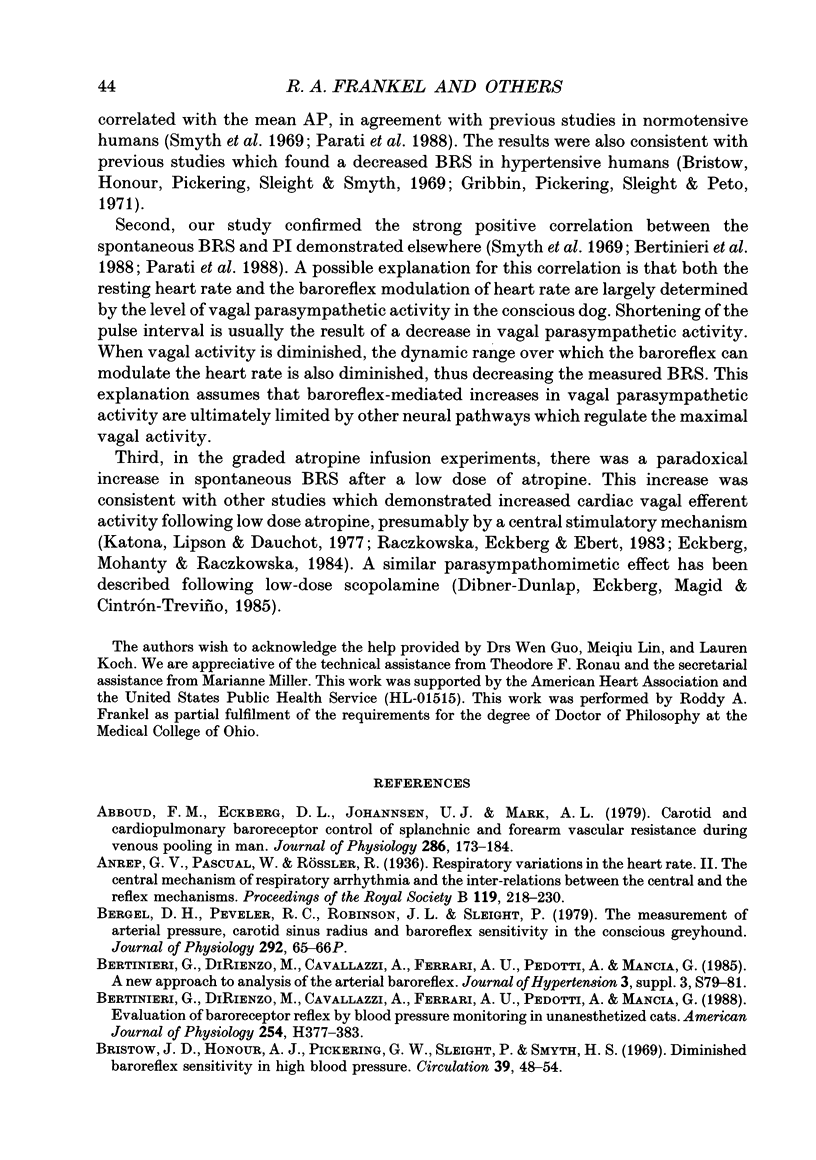
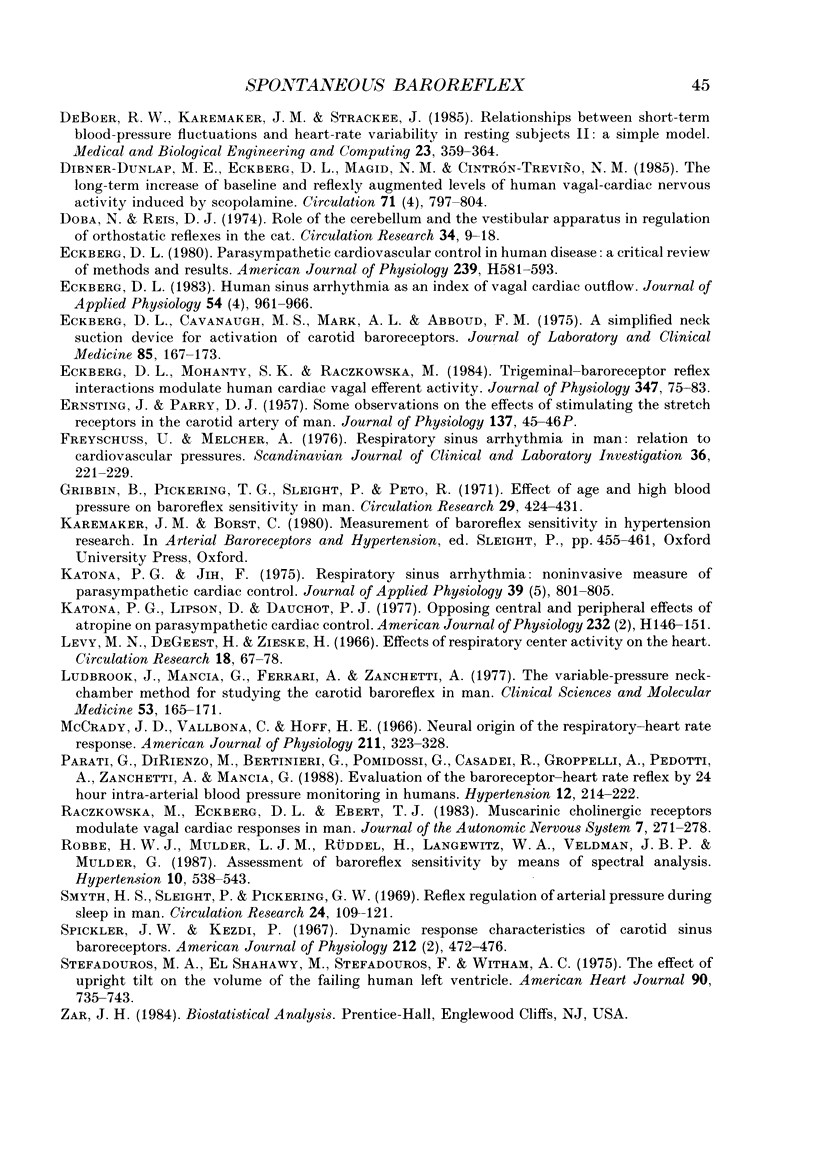
Selected References
These references are in PubMed. This may not be the complete list of references from this article.
- Abboud F. M., Eckberg D. L., Johannsen U. J., Mark A. L. Carotid and cardiopulmonary baroreceptor control of splanchnic and forearm vascular resistance during venous pooling in man. J Physiol. 1979 Jan;286:173–184. doi: 10.1113/jphysiol.1979.sp012612. [DOI] [PMC free article] [PubMed] [Google Scholar]
- Bergel D. H., Peveler R. C., Robinson J. L., Sleight P. The measurement of arterial pressure, carotid sinus radius and baroreflex sensitivity in the conscious greyhound [proceedings]. J Physiol. 1979 Jul;292:65P–66P. [PubMed] [Google Scholar]
- Bertinieri G., Di Rienzo M., Cavallazzi A., Ferrari A. U., Pedotti A., Mancia G. Evaluation of baroreceptor reflex by blood pressure monitoring in unanesthetized cats. Am J Physiol. 1988 Feb;254(2 Pt 2):H377–H383. doi: 10.1152/ajpheart.1988.254.2.H377. [DOI] [PubMed] [Google Scholar]
- Bristow J. D., Honour A. J., Pickering G. W., Sleight P., Smyth H. S. Diminished baroreflex sensitivity in high blood pressure. Circulation. 1969 Jan;39(1):48–54. doi: 10.1161/01.cir.39.1.48. [DOI] [PubMed] [Google Scholar]
- Dibner-Dunlap M. E., Eckberg D. L., Magid N. M., Cintrón-Treviño N. M. The long-term increase of baseline and reflexly augmented levels of human vagal-cardiac nervous activity induced by scopolamine. Circulation. 1985 Apr;71(4):797–804. doi: 10.1161/01.cir.71.4.797. [DOI] [PubMed] [Google Scholar]
- Doba N., Reis D. J. Role of the cerebellum and the vestibular apparatus in regulation of orthostatic reflexes in the cat. Circ Res. 1974 Jan;34(1):9–18. doi: 10.1161/01.res.40.4.9. [DOI] [PubMed] [Google Scholar]
- Eckberg D. L., Cavanaugh M. S., Mark A. L., Abboud F. M. A simplified neck suction device for activation of carotid baroreceptors. J Lab Clin Med. 1975 Jan;85(1):167–173. [PubMed] [Google Scholar]
- Eckberg D. L. Human sinus arrhythmia as an index of vagal cardiac outflow. J Appl Physiol Respir Environ Exerc Physiol. 1983 Apr;54(4):961–966. doi: 10.1152/jappl.1983.54.4.961. [DOI] [PubMed] [Google Scholar]
- Eckberg D. L., Mohanty S. K., Raczkowska M. Trigeminal-baroreceptor reflex interactions modulate human cardiac vagal efferent activity. J Physiol. 1984 Feb;347:75–83. doi: 10.1113/jphysiol.1984.sp015054. [DOI] [PMC free article] [PubMed] [Google Scholar]
- Eckberg D. L. Parasympathetic cardiovascular control in human disease: a critical review of methods and results. Am J Physiol. 1980 Nov;239(5):H581–H593. doi: 10.1152/ajpheart.1980.239.5.H581. [DOI] [PubMed] [Google Scholar]
- Freyschuss U., Melcher A. Respiratory sinus arrhythmia in man: relation to cardiovascular pressures. Scand J Clin Lab Invest. 1976 May;36(3):221–229. [PubMed] [Google Scholar]
- Gribbin B., Pickering T. G., Sleight P., Peto R. Effect of age and high blood pressure on baroreflex sensitivity in man. Circ Res. 1971 Oct;29(4):424–431. doi: 10.1161/01.res.29.4.424. [DOI] [PubMed] [Google Scholar]
- Katona P. G., Jih F. Respiratory sinus arrhythmia: noninvasive measure of parasympathetic cardiac control. J Appl Physiol. 1975 Nov;39(5):801–805. doi: 10.1152/jappl.1975.39.5.801. [DOI] [PubMed] [Google Scholar]
- Katona P. G., Lipson D., Dauchot P. J. Opposing central and peripheral effects of atropine on parasympathetic cardiac control. Am J Physiol. 1977 Feb;232(2):H146–H151. doi: 10.1152/ajpheart.1977.232.2.H146. [DOI] [PubMed] [Google Scholar]
- Levy M. N., DeGeest H., Zieske H. Effects of respiratory center activity on the heart. Circ Res. 1966 Jan;18(1):67–78. doi: 10.1161/01.res.18.1.67. [DOI] [PubMed] [Google Scholar]
- Ludbrook J., Mancia G., Ferrari A., Zanchetti A. The variable-pressure neck-chamber method for studying the carotid baroreflex in man. Clin Sci Mol Med. 1977 Aug;53(2):165–171. doi: 10.1042/cs0530165. [DOI] [PubMed] [Google Scholar]
- McCrady J. D., Vallbona C., Hoff H. E. Neural origin of the respiratory-heart rate response. Am J Physiol. 1966 Aug;211(2):323–328. doi: 10.1152/ajplegacy.1966.211.2.323. [DOI] [PubMed] [Google Scholar]
- Parati G., Di Rienzo M., Bertinieri G., Pomidossi G., Casadei R., Groppelli A., Pedotti A., Zanchetti A., Mancia G. Evaluation of the baroreceptor-heart rate reflex by 24-hour intra-arterial blood pressure monitoring in humans. Hypertension. 1988 Aug;12(2):214–222. doi: 10.1161/01.hyp.12.2.214. [DOI] [PubMed] [Google Scholar]
- Raczkowska M., Eckberg D. L., Ebert T. J. Muscarinic cholinergic receptors modulate vagal cardiac responses in man. J Auton Nerv Syst. 1983 Mar-Apr;7(3-4):271–278. doi: 10.1016/0165-1838(83)90080-2. [DOI] [PubMed] [Google Scholar]
- Robbe H. W., Mulder L. J., Rüddel H., Langewitz W. A., Veldman J. B., Mulder G. Assessment of baroreceptor reflex sensitivity by means of spectral analysis. Hypertension. 1987 Nov;10(5):538–543. doi: 10.1161/01.hyp.10.5.538. [DOI] [PubMed] [Google Scholar]
- Smyth H. S., Sleight P., Pickering G. W. Reflex regulation of arterial pressure during sleep in man. A quantitative method of assessing baroreflex sensitivity. Circ Res. 1969 Jan;24(1):109–121. doi: 10.1161/01.res.24.1.109. [DOI] [PubMed] [Google Scholar]
- Spickler J. W., Kezdi P. Dynamic response characteristics of carotid sinus baroreceptors. Am J Physiol. 1967 Feb;212(2):472–476. doi: 10.1152/ajplegacy.1967.212.2.472. [DOI] [PubMed] [Google Scholar]
- Stefadouros M. A., El Shahawy M., Stefadouros F., Witham A. C. The effect of upright tilt on the volume of the failing human left ventricle. Am Heart J. 1975 Dec;90(6):735–743. doi: 10.1016/0002-8703(75)90463-9. [DOI] [PubMed] [Google Scholar]
- de Boer R. W., Karemaker J. M., Strackee J. Relationships between short-term blood-pressure fluctuations and heart-rate variability in resting subjects. II: A simple model. Med Biol Eng Comput. 1985 Jul;23(4):359–364. doi: 10.1007/BF02441590. [DOI] [PubMed] [Google Scholar]


